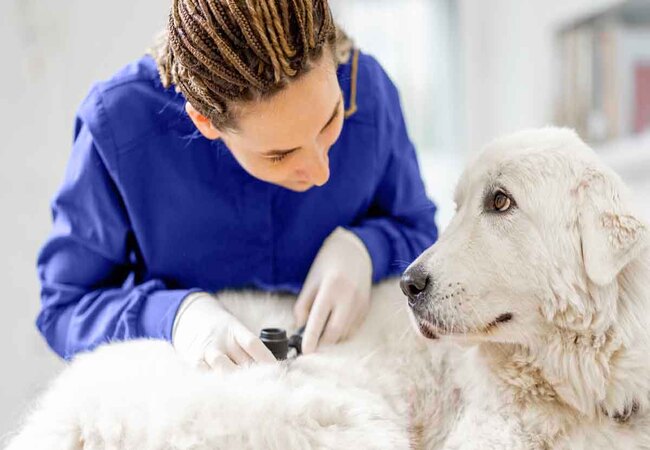Canine Melanoma 2025: Vet-Approved Detection & Treatment Guide 🐕⚕️

In this article
Veterinary Guide to Canine Melanoma 2025 🩺🐶
By Dr. Duncan Houston BVSc
🧬 What Is Melanoma?
Melanoma is a tumor of pigment-producing melanocytes. While many skin melanomas are benign, malignant forms—especially in the mouth, digits, and eyes—can spread rapidly.
📍 Types of Canine Melanoma
- Oral melanoma: Most common and aggressive—accounts for ~36% of canine oral tumors.
- Digital melanoma: Occurs in the nail bed or toes—about 25% of digit tumors, often with bone invasion.
- Ocular melanoma: Affects eyelids, uvea, and conjunctiva, often slower to spreads.
- Cutaneous (skin) melanoma: Usually benign (~90%), though some may be malignant.
⚠️ Clinical Signs by Location
- Oral: bad breath, drooling, oral mass, difficulty eating, weight loss.
- Digital: limp, paw licking, irregular or loose nail, swelling/pain.
- Ocular: vision loss, eye bulging, color changes.
- Cutaneous: pigmented lump—black, brown, or even pink (amelanotic).
🔍 Risk Factors & Causes
- Primarily dogs ≥9 years old; certain breeds (Golden Retrievers, Chows, Schnauzers, Terriers) overrepresented.
- No strong link to sun exposure as in humans.
- Genetic predisposition plays a key role.
🔬 Diagnostic Approach
- Physical exam: check oral cavity, toes, eyes, and skin.
- FNA or biopsy: to confirm diagnosis and melanoma type.
- Staging scans: chest X-ray or CT, abdominal ultrasound, and regional lymph node aspirate to evaluate metastasis.
- Ancillary tests: CBC, chemistry, urinalysis to assess overall health.
🛠️ Treatment Options
🔪 Surgery
The goal is a wide excision with clear margins. Oral melanoma may require partial jaw removal; digital may require toe amputation; skin tumors removed locally.
💉 Advanced Therapies
- Radiation therapy: palliative or adjunct post-surgery.
- Chemotherapy and targeted agents: e.g., carboplatin, lomustine, toceranib; often adjunct.
- Immunotherapy – melanoma vaccine: ONCEPT® DNA vaccine for stage II–III oral melanoma extends survival times.
- Immune checkpoint inhibitors: emerging use in refractory oral cases.
📈 Prognosis
- Varies by type and stage: benign skin melanomas have an excellent prognosis; oral/digital have more guarded outcomes.
- Stage I oral melanoma treated with surgery + vaccine can reach 1.5+ years survival; higher stages have shorter outlook (months).
- Benign cutaneous melanomas are often cured with surgery.
📱 Ask A Vet Telehealth Integration
- 📸 Submit photos of oral lesions, toes, and eyes for remote triage.
- 🔔 Notifications for biopsy scheduling, vaccine dosing, and follow-up scans.
- 🩺 Live check-ins to assess healing, appetite, pain, and mobility.
- 💊 Purrz delivers pain meds, supplements, and vaccines to your door.
- 🧠 Woopf logs comfort levels, weight, side effects, and activity trends.
🎓 Case Spotlight: “Lola” the Golden Retriever
Lola, a 9‑year‑old Golden, presented with a pigmented mass under her tongue and halitosis. Diagnosis: Stage II oral melanoma with lymph node involvement. Treated with mandibulectomy, radiation, and ONCEPT® vaccine. Ask A Vet coordinated staging, telehealth monitoring, med delivery, and helped her surpass the initial 6‑month prognosis, surviving >18 months post-treatment with maintained quality of life🐾.
🔚 Key Takeaways
- Melanoma can be benign (skin) or malignant (oral, digital, ocular).
- Early detection is critical—masses in the mouth, toes, or eyes require prompt screening.
- Surgery is the primary treatment; advanced cases benefit from radiation, vaccine, chemo, or immunotherapy.
- Prognosis depends on tumor location, stage, and treatment, and can range from cure to months of survival.
- Ask A Vet telehealth supports early detection, streamlined diagnostics, treatment coordination, and home care excellence 📲🐕
Dr Duncan Houston BVSc, founder of Ask A Vet. Download the Ask A Vet app to access expert telehealth and holistic care for melanoma—bringing staging help, telemonitoring, medications, pain control, and remote follow‑ups right to your home 🐶📲






